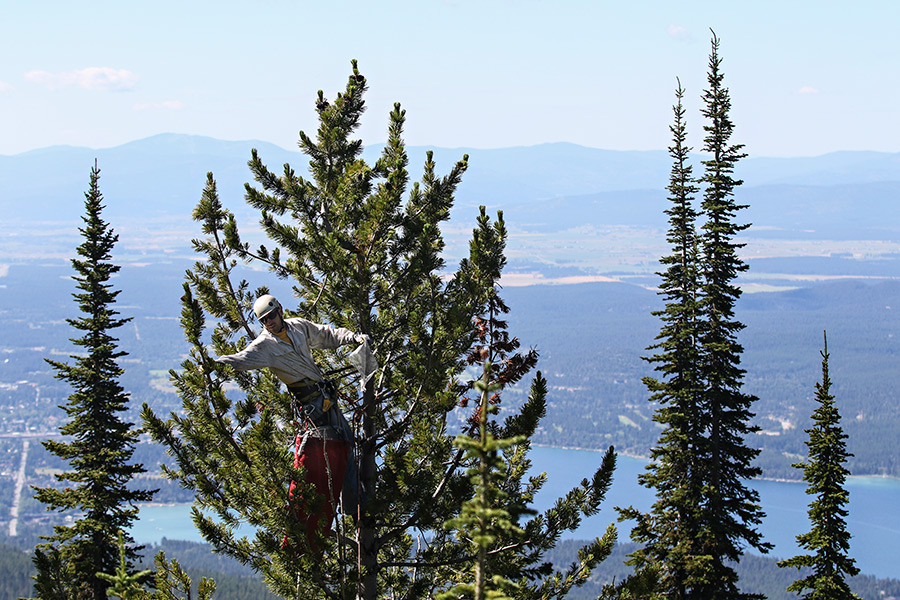WHITEFISH — To the uninitiated, the stark beauty of a whitebark pine is revealed only after the tree has died and shed its needles, leaving behind a vertical boneyard of wind-twisted limbs that writhes in the high-alpine sky like a ghostly apparition.
At the height of vitality, however, the whitebark pine is only distinct from other verdant stands of conifers to the trained eye despite the network of wildlife they sustain.
Foresters and researchers who understand the critical ecological importance of the keystone species are striving to reanimate these ghost forests, and may be closing in on a strategy to ensure their future survival, as well as that of the many wildlife species who depend on its nutrient-dense cones.
As a candidate species for listing under the Endangered Species Act, the alternative could be a major environmental loss.
The key to unlocking a strategy for recovery lies in the success of a program to promote extra-hearty strains of whitebark pine that have developed a genetic resistance to blister rust, an invasive fungus that followed western settlement of the Rocky Mountains, wiping out most of the whitebark stands in Glacier National Park and the Bob Marshall Wilderness Complex nearly a century ago.
Melissa Jenkins, forest silviculturist for the Flathead National Forest, said whitebark pine once grew in approximately 13 percent of the 2.5 million-acre Flathead National Forest, but blister rust, mountain pine beetles and climate change have combined to take a toll on the species — today, more than 90 percent of whitebark pine habitat has been decimated, and without action the species will become functionally extinct, Jenkins said.
“Humans created this problem, and because we created this problem, we have a responsibility to restore this tree,” she said.
The Flathead National Forest is one of several forests in Montana that is taking steps that Jenkins hopes will halt the extirpation and allow the species to rebound, and in Whitefish forest officials have collaborated with Whitefish Mountain Resort to help recover the species and educate the public about its importance.
Last week at the resort on Big Mountain, which recently became the first “Whitebark Pine Friendly Ski Area” through a certification process established by the Whitebark Pine Ecosystem Foundation, a team of restoration specialists spent a hot summer day scaling a passel of whitebark pine trees, which they wrapped in protective mesh to safeguard the still-ripening cones.
The cone-caging work is part of an effort to stop the disappearance of the species from the region, and the ski area is one of 14 sites on the Flathead National Forest where researchers are trying to reverse the decline.
The tree climbers are hired on contract by the U.S. Forest Service each year to collect seeds from whitebark pine stands believed to have developed a genetic resistance to blister rust. The seeds are caged in July and left to ripen until September, when the tree climbers return to collect them.
Then, the seeds are sent to the regional Forest Service nursery in Coeur d’Alene, Idaho, where they undergo a battery of genetic tests before they are propagated. At the nursery, their genetic armor is rigorously tested through an intensive regimen of exposure to blister rust fungus spores.
“It’s like a perfect rust heaven,” Jenkins said of the nursery’s environs.
The seedlings that survive the blister-rust boot camp are grafted to existing whitebark roots to speed up the cone-bearing process.
Through this years-long process, the whitebarks are slowly being placed back on the landscape.
“It can take 50 to 70 years before whitebarks start producing cones, so this is how we accelerate the process,” said Karl Anderson, a forest culturist with the Flathead National Forest. “It is a culmination of a lot of hard work that has been a very time consuming and costly, but we think it will be worth it.”
Anderson has been studying whitebark pine since the national forest began the program in 1994, but he said the project didn’t involve caging the cones until 2002, when foresters realized they needed to protect the seeds from the Clark’s nutcracker.
The Clark’s nutcracker has evolved a mutualistic relationship with whitebark pine — the whitebark provides the bird’s preferred food, and the bird, in turn, is responsible for most whitebark pine dispersal and regeneration.
“The Clark’s nutcracker is the primary vector for seed dispersal,” Jenkins said, adding that a single nutcracker can carry up to 100 whitebark seeds at a time, using a specially evolved hole in its throat to ferry the seeds to a cache.
The Clark’s nutcracker stores the seeds underground for spring feeding to chicks. A single Clark’s nutcracker can cache up to 98,000 seeds in a season, many of which it forgets to retrieve before the seeds germinate, thus propagating the tree.
Whitebark pine seeds also provide “Big Mac” equivalents of nutrient-rich calories to grizzly bears, which sniff out stockpiles of seeds stored by red squirrels.
Whitebark pines are also considered a foundation species, because they create a stable environment for other trees and plants.
As “nurse trees,” they are the first to grow in high-elevation environments following major disturbances, such as a fire. Once they grow, they provide shelter and a gentler microenvironment in which other species, such as firs and spruces, can grow. Whitebark pines also reduce soil erosion and help to retain snow long into the summer, which in turn helps prevent spring floods and summer droughts.
“This is a keystone species, and we believe this area may be poised for restoration,” Jenkins said.
